ตำรามาตรฐานยาสมุนไพรไทย
Thai Herbal Pharmacopoeia
สำนักยาและวัตถุเสพติด กรมวิทยาศาสตร์การแพทย์ กระทรวงสาธารณสุข
Bureau of Drug and Narcotic, Department of Medical Sciences, Ministry of Public Health(Tinospora crispa (L.) Hook.f. & Thomson)
(Nelumbo nucifera Gaertn.)
(Centella asiatica (L.) Urb.)
(Centella Dry Extract)
(Centella Cream)
(Mesua ferrea L.)
(Piper sarmentosum Roxb.)
(Piper sarmentosum Roxb.)
(Pterocarpus santalinus L. f.)
(Santalum album L.)
(Senna tora (L.) Roxb.)
(Senna alata (L.) Roxb.)
(Senna Alata Tea)
(Piper retrofractum Vahl)
(Myristica fragrans Houtt)
(Andrographis paniculata (Burm. f.) Nees)
(Andrographis Capsules)
(Allium ascalonicum L.)
(Ocimum tenuiflorum L.)
(Curcuma longa L.)
(Turmeric Capsules)
(Turmeric Dry Extract)
(Turmeric Dry Extract Capsules)
(Arcangelisia flava (L.) Merr.)
(Curcuma sp.)
Harrisonia perforata (Blanco) Merr.
(Aristolochia pierrei Lecomte)
(Zingiber officinale Roscoe)
(Ginger Capsules)
(Ginger Tea)
(Cassia fistula L.)
(Nardostachys jatamansi (D. Don) DC.)
(Angelica sinensis (Oliv.) Diels)
Artemisia annua L.
(Ligusticum sinense Oliv. cv. Chuanxiong)
(Neopicrorhiza scrophulariiflora Pennell)
(Atractylodes lancea (Thunb.) DC.)
(Aucklandia lappa Decne)
(Terminalia chebula Retz.)
(Angelica dahurica (Hoffm.) Benth. & Hook. f. ex Franch. & Sav. var. dahurica)
(Kaempferia parviflora Wall. ex Baker)
(Hibiscus sabdariffa L.)
(Roselle Tea)
(Allium sativum L.)
(Zingiber zerumbet (L.) Sm.)
(Wurfbainia testacea (Ridl.) Škorničk.& A. D. Poulsen)
(Cannabis sativa L.)
(Myristica fragrans Houtt)
(Dracaena cochinchinensis (Lour.) S. C. Chen)
(Ficus racemosa L.)
(Hyptis suaveolens (L.) Poit.)
Clerodendrum indicum (L.) Kuntze
(Phyllanthus emblica L.)
(Citrus hystrix DC.)
(Citrus hystrix DC.)
(Areca catechu L.)
(Momordica charantia L.)
Moringa oleifera Lam.
(Aegle marmelos (L.) Corrêa)
(Solanum trilobatum L.)
(Morus alba L.)
Gynostemma pentaphyllum(Thunb.)
Makino
(Clinacanthus nutans (Burm. f.) Lindau)
(Cissus quadrangularis L.)
(Mimusops elengi L.)
(Zingiber montanum (J. König) Link. ex A. Dietr.)
(Piper betle L.)
(Capsicum annuum L.)
(Capsicum Oleoresin)
(Capsicum Gel)
(Piper nigrum L.)
(Piper nigrum L.)
(Eurycoma longifolia Jack)
(Thunbergia laurifolia Lindl.)
(Piper wallichii (Miq.) Hand.-Mazz.)
Senna garrettiana (Craib) H. S. Irwin & Barneby
(Terminalia bellirica (Gaertn.) Roxb.)
(Terminalia chebula Retz.)
(Caesalpinia bonduc (L.) H. Roxb.)
(Tarlmounia elliptica (DC.) H. Rob., S. C. Keeley, Skvaria & R. Chan)
(Hog Creeper Vine Dry Extract Capsiles)
(Hog Creeper Vine Dry Extract)
(Brachypterum scandens (Roxb.) Miq.)
(Lepidium sativum L.)
(Nigella sativa L.)
(Cuminum cyminum L.)
(Foeniculum vulgare Mill.)
(Plantago ovata Forssk.)
(Pimpinella anisum L.)
(Carum carvi L.)
(Anethum graveolens L.)
(Trachyspermum ammi (L.) Sprague)
Albizia procera (Roxb.) Benth.
(Acorus calamus L.)
(Tiliacora triandra (Colebr.) Diels)
Cyanthillium cinereum (L.) H. Rob.
(Orthosiphon aristatus (Blume) Miq.)
Murdannia loriformis (Hassk.) R. S. Rao & Kammathy
(Capparis micracantha DC.)
(Chrysopogon zizanioides (L.) Roberty)
(Cyperus rotundus L.)
(Cannabis sativa L.)
(Syzygium aromaticum (L.) Merr. & L. M. Perry)
(Boesenbergia rotunda (L.) Mansf.)
(Acanthus ebracteatus Vahl)
(Acanthus ilicifolius L.)
(Kaempferia galanga L.)
(Curcuma comosa Roxb.)
Betula alnoides Buch.-Ham. ex D. Don
Cannabis sativa L.
Carthamus tinctorius L
Mitragyna speciosa (Korth.) Havil
Mallotus repandus (Rottler) Müll. Arg
Azadirachta indica A. Juss. var. siamensis Valeton
Azadirachta indica A. Juss. var. siamensis Valeton
Punica granatum L.
Rhinacanthus nasutus (L.) Kurz
Baliospermum solanifolium (Burm.) Suresh
Curcuma aeruginosa Roxb
Boesenbergia kingii Mood & L. M. Prince
Senegalia rugata (Lam.) Britton & Rose
Acacia concinna (Willd.) DC.
Senegalia rugata (Lam.) Britton & Rose
Acacia concinna (Willd.) DC.
Senna alexandriana Mill. var. alexandriana
Cassia acutifolia Delile, Cassia angustifolia Vahl
Butea superba Roxb. ex Willd.
[Plaso superba (Roxb. ex Willd.) Kuntze, Rudolphia superba (Roxb. ex Willd.) Poir.
Pueraria candollei Graham
ex Benth. var. mirifica (Airy Shaw & Suvat.) Niyomdham
Streblus asper Lour.
Suregada multiflora (A. Juss.) Baill. (Gelonium
multiflorum A. Juss.
Sweet Wormwood Herb is the dried aerial part of Artemisia annua L. (Family Compositae), Herbarium Specimen Number: see Additional information 1, Crude Drug Number: DMSc 1147.
(Note Sweet Wormwood Herb should be harvested during the blooming period.)
Constituents Sweet Wormwood Herb contains sesquiterpenoids (e.g., artemisinin, artemisinic acid, arteannuin B). It also contains volatile oil, flavonoids, coumarins, etc.
Description of the plant (Figs. 1a, 1b) Annual herb, 70 to 150 cm tall; fragrant; stem furrowed, much branched, puberulous, soon glabrous. Leaves simple, spirally arranged, oblong or ovate in outline, 3- or 4- pinnatipartited, glandular-dotted; petioles of middle cauline leaves 1 to 2 cm long; radical leaves withering early; lowermost cauline leaves ovate or triangular-ovate, 3 to 7 cm long, 2 to 6 cm wide; segments 5 to 10 pairs; lobule deeply serrate; tooth triangular, 1 to 2 mm long, 0.5 mm wide; midvein prominent adaxially; rachis narrowly winged, sparsely serrate; middle cauline leaves 2- or 3-pinnati or pectinatisect; upper leaves and leafy bract 1- or 2- pinnatipartited. Inflorescences in broad pyramidal paniculate; capitula globose, numerous, 1 to 3 mm in diameter, nodding, shortly pedicellate; bract linear, ovalacuminate or oval; involucre globose, glabrous; phyllaries 2 to 3 seriate, the outer ones narrowly oblong, green, the inner elliptic or obovate, margin hyaline. Marginal florets pistillate, 10 to 18, minute; disc florets bisexual, 10 to 30, minute, dark yellow or yellow. Achene ellipsoid-ovoid, faintly nerved, glabrous.
Description Odour, characteristic and aromatic; taste, slightly bitter
Macroscopical (Fig. 1a) Stems, vary in diameter and length, cylindrical, furrowed, greenish brown to brown; texture slightly hard, fracture medullated in the centre. Leaves, greenish brown to brown, rolled and crumpled, easily broken. Capitula abundant, 2 to 3 mm in diameter.
Microscopical (Figs. 2a, 2b, 2c, 2d, 2e) Transverse section of the fresh leaflet shows epidermis, mesophyll and vascular bundle. Epidermis, a layer of rectangular cells with glandular trichomes and slightly raised stomata, T-shape trichomes may be seen. Mesophyll, bifacial, 1 to 3 layers of palisade cells and thin-walled parenchyma cells in between. Vascular bundle, xylem in the upper part and phloem in the lower part.
Transverse section of the fresh stem illustrates epidermal layer, cortex, vascular tissue, and pith. Epidermal layer, rectangular cells, covered with cuticle layer. Cortex, few layers of angular collenchyma cells, groups of angular collenchyma cells and groups of cortical fibre cells in small ridges. Vascular tissue, narrow zone of phloem tissue, vascular cambium, large zone of xylem tissue, and 1 to 3 layers of medullar rays. Pith, numerous polygonal parenchyma cells.
1The two Thai names, โกฐจุฬาลัมพา and โกดจุฬาลัมพา, are spelled differently in Thai. However, both term can be transcribed into the same English phonetic transcription "KOT CHULA LAMPHA".
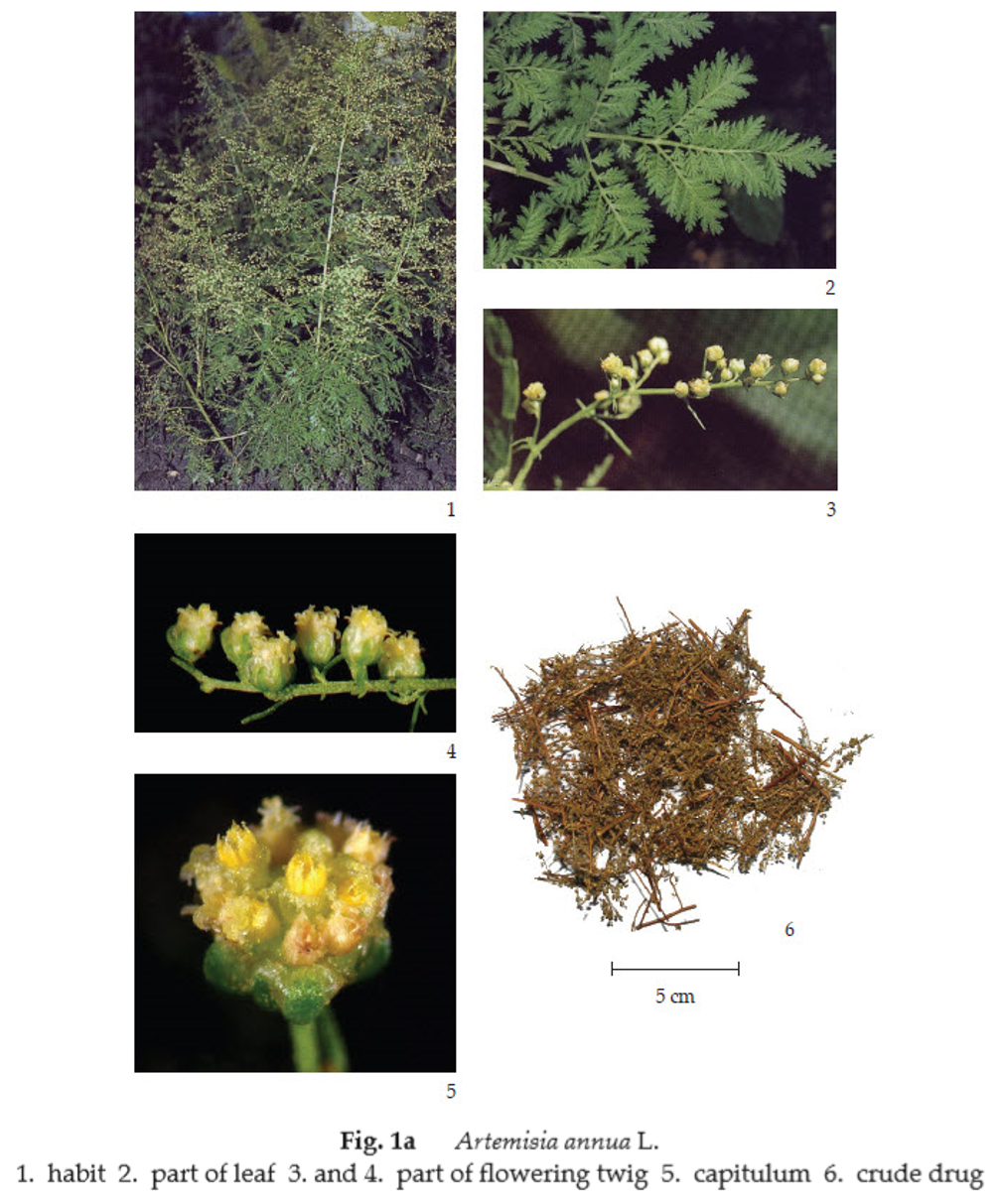
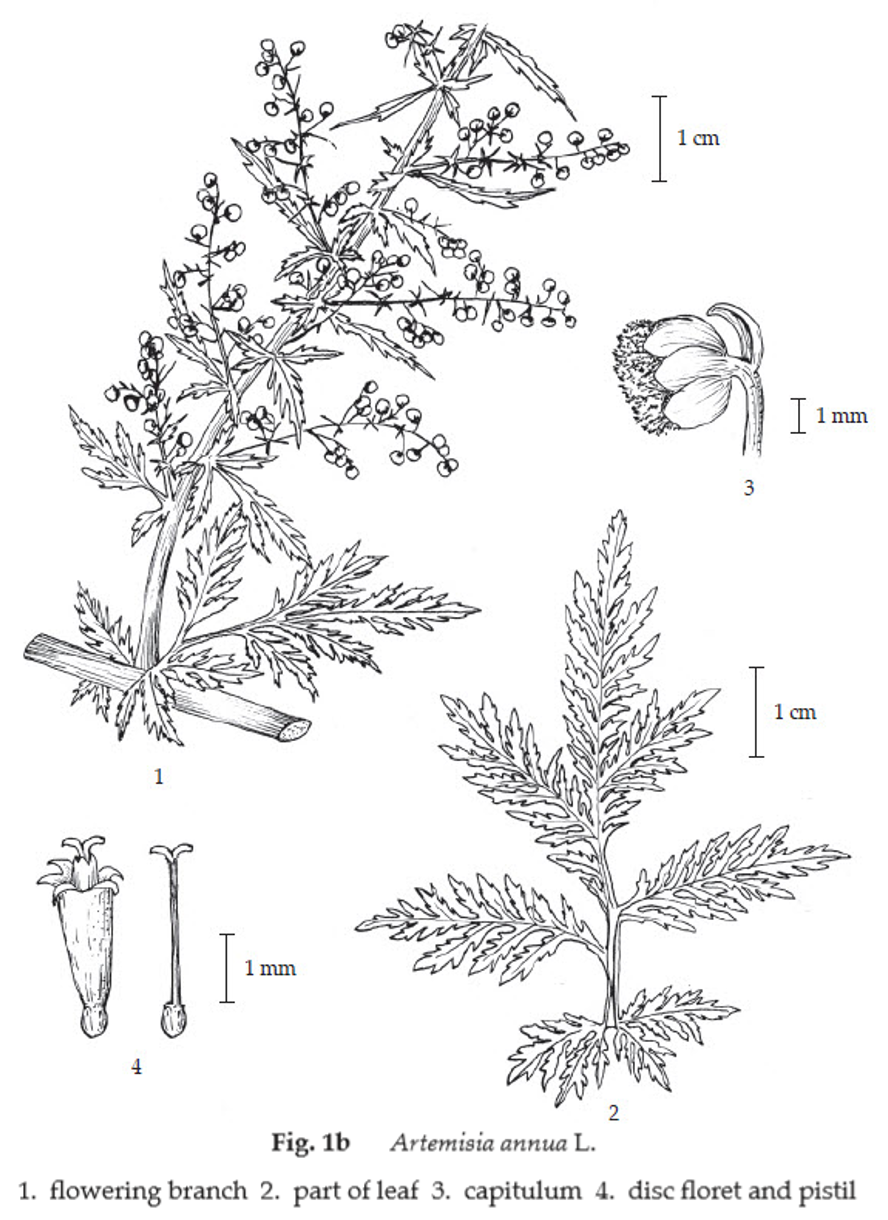
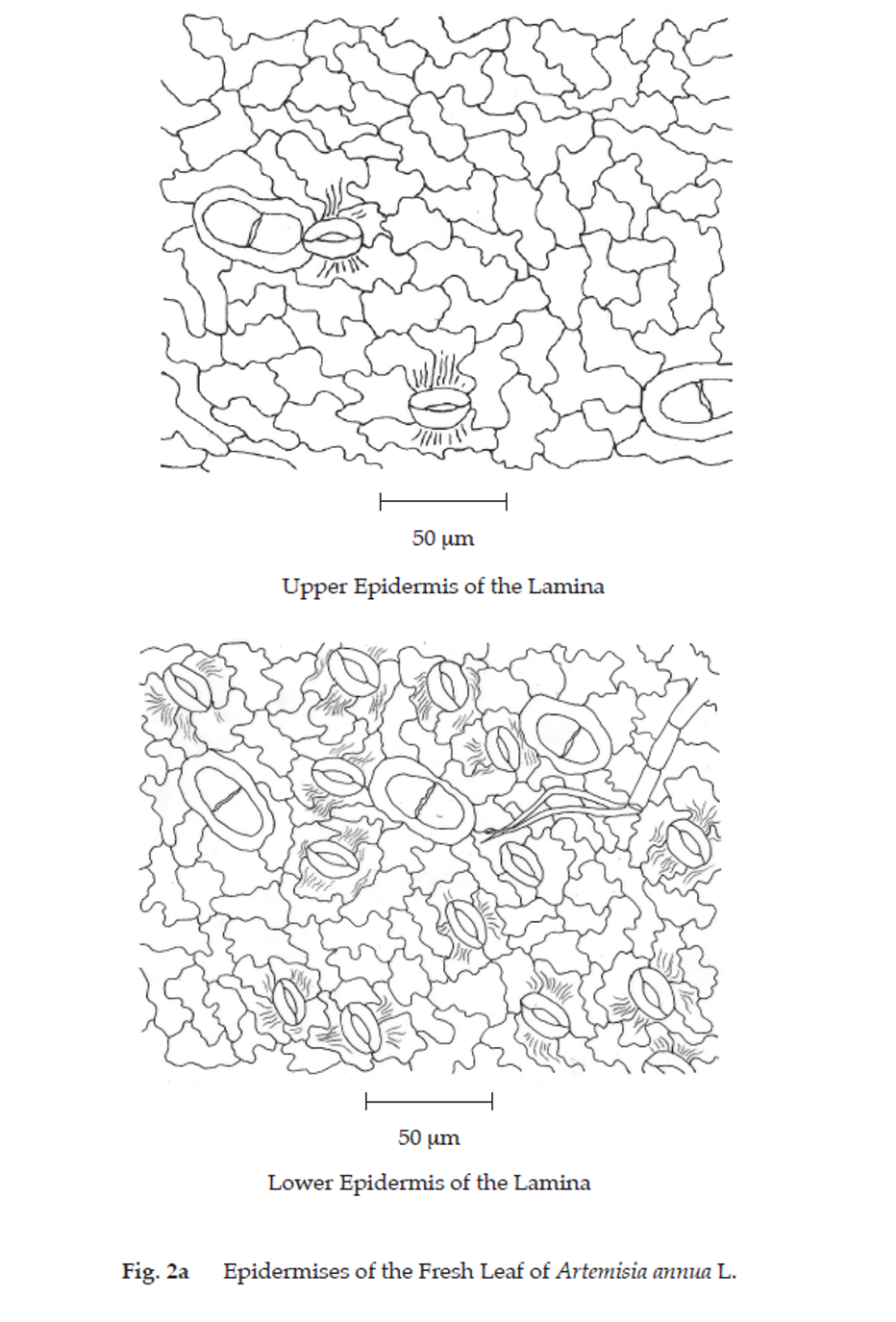
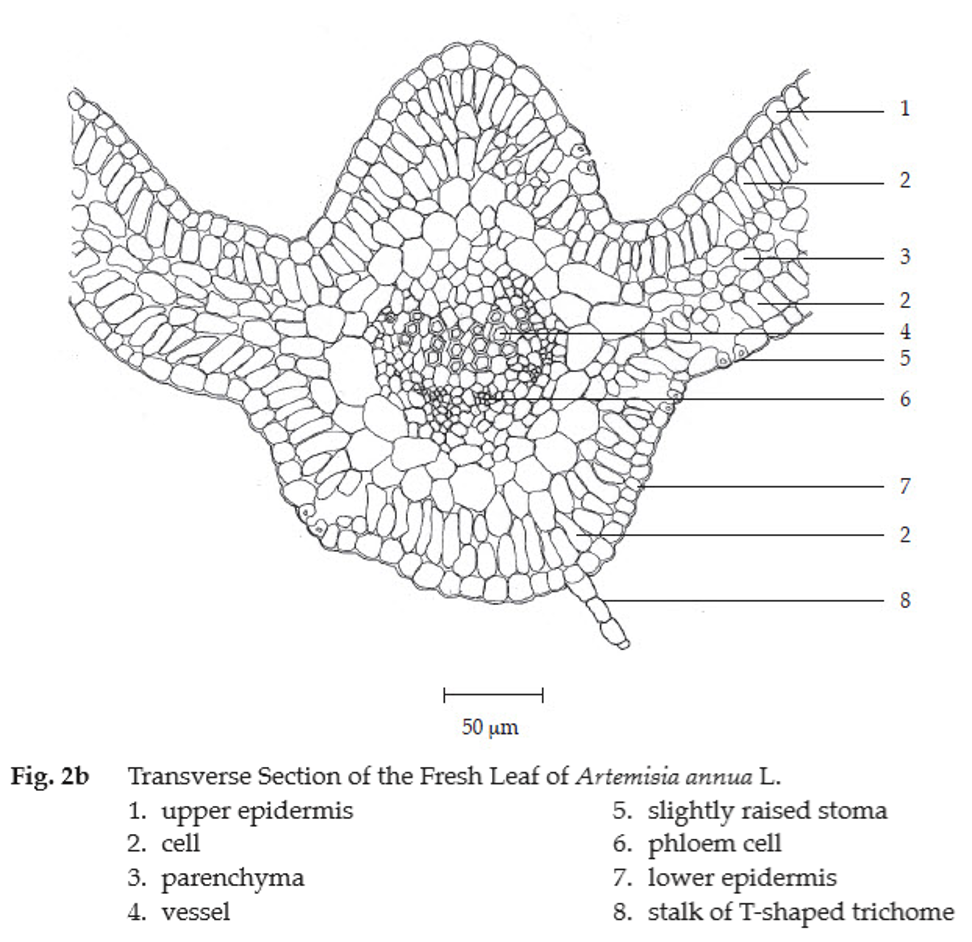
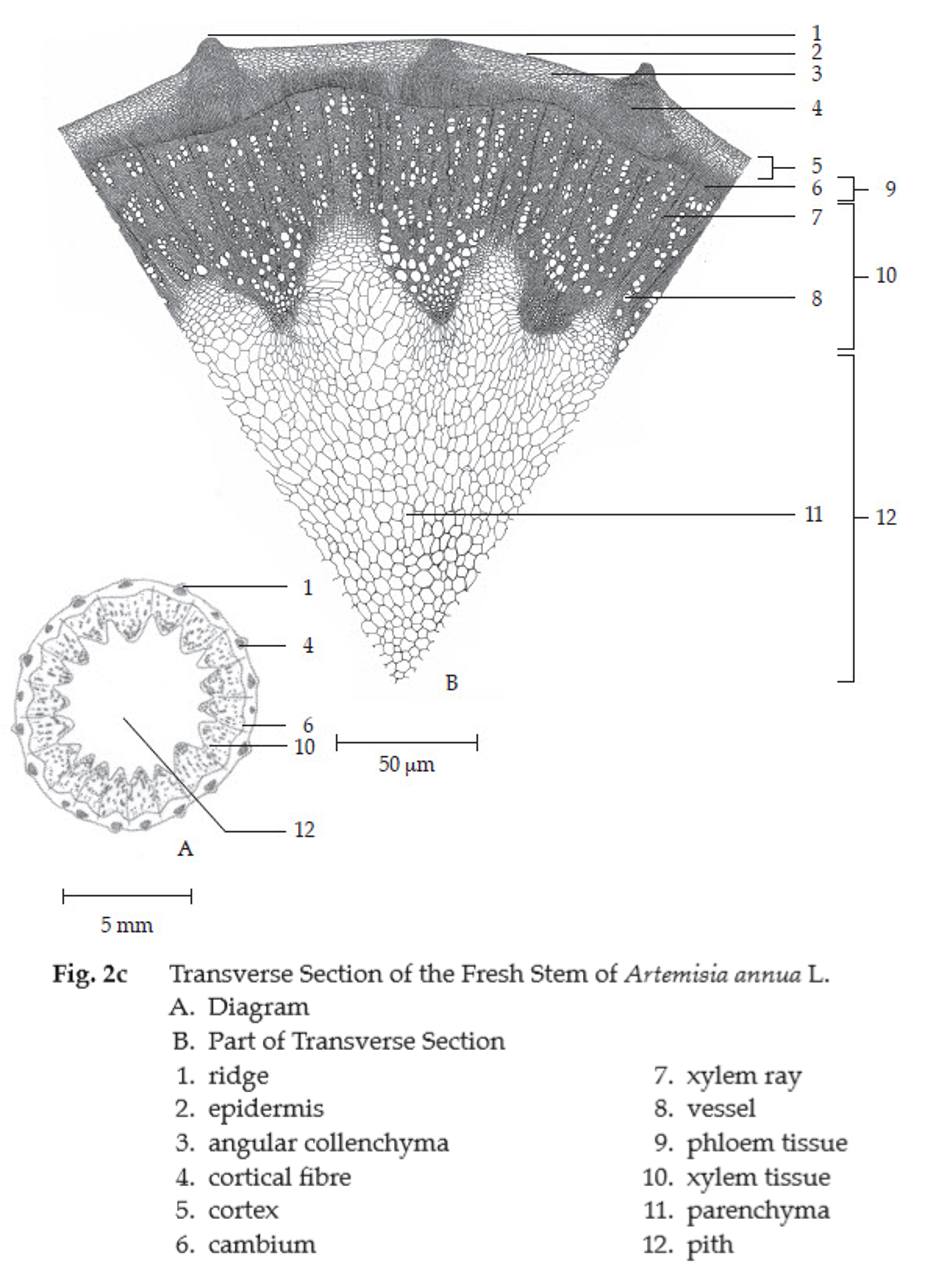

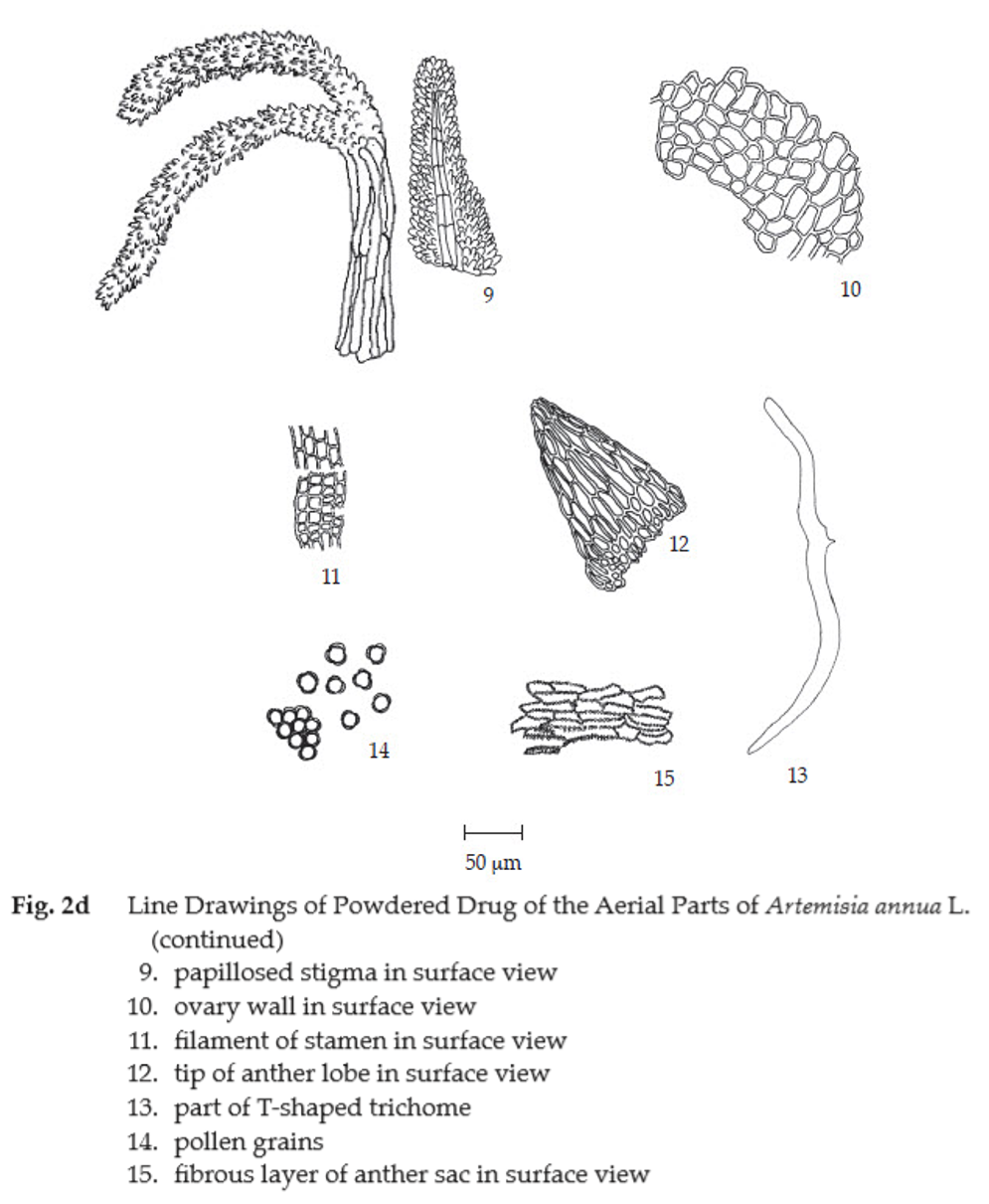
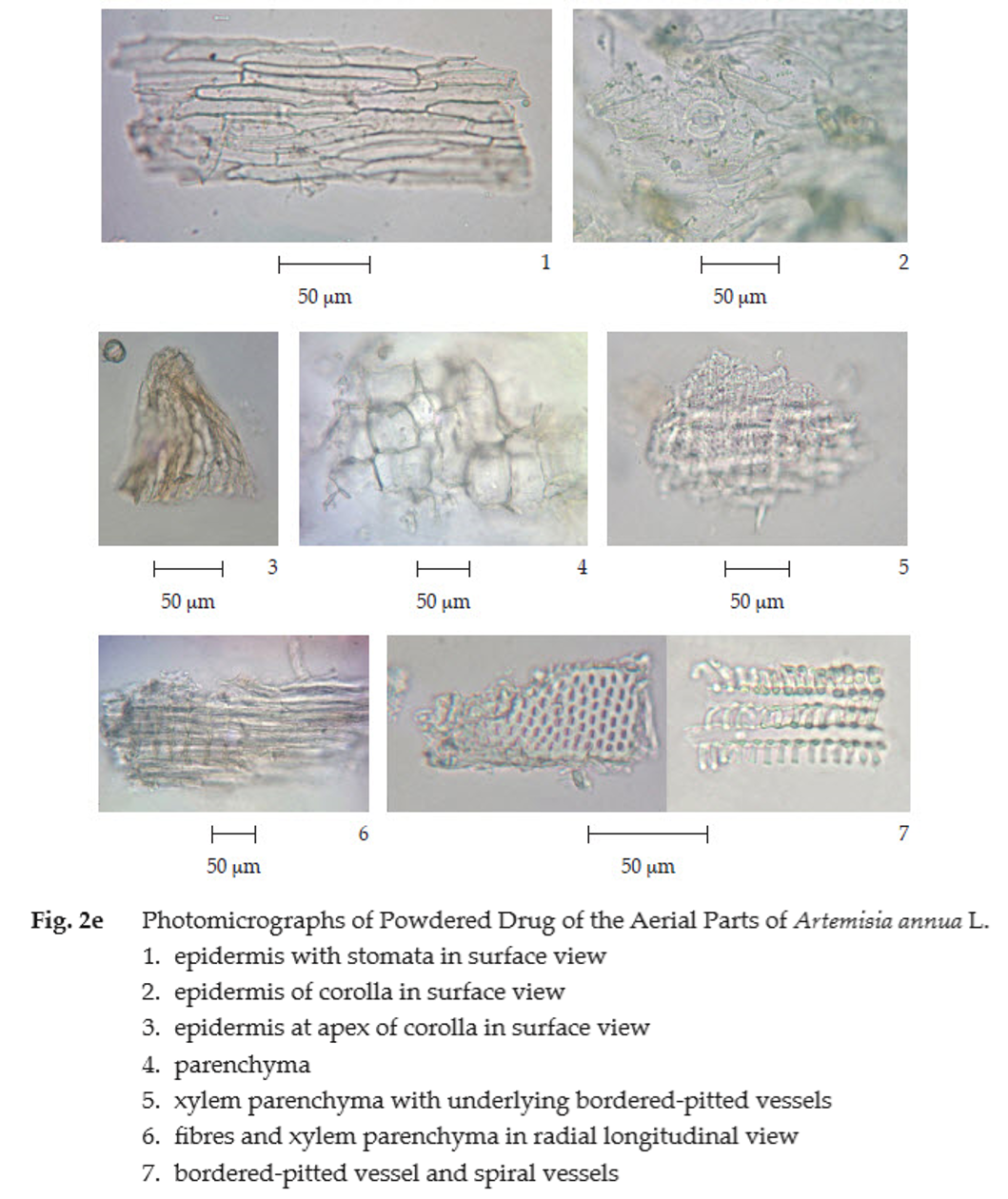
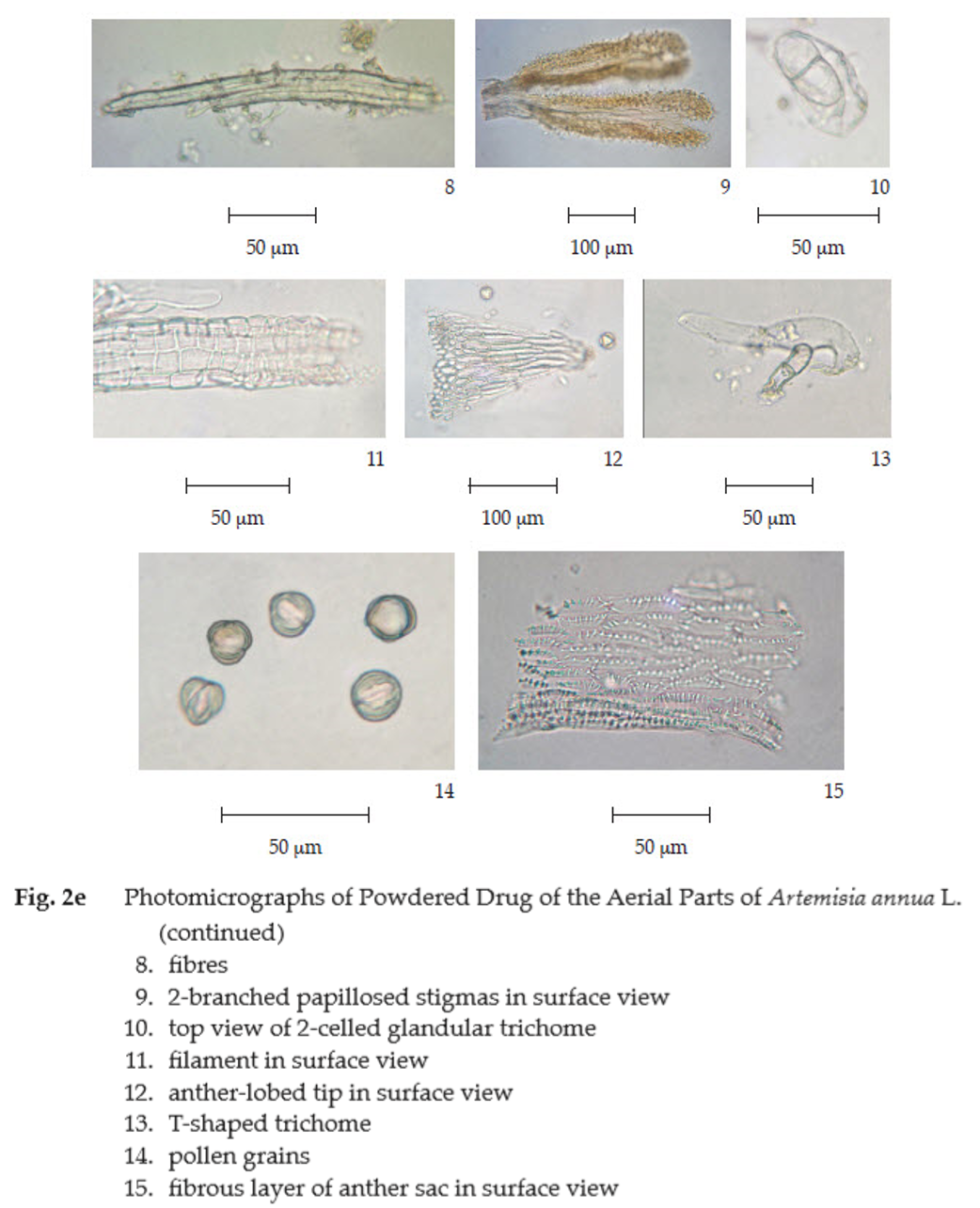
Sweet Wormwood Herb in powder possesses the diagnostic microscopical characters of the unground drug. Two-celled glandular trichomes, 2-branched papillosed stigmas, tip of anther lobes, and triporate pollen grains are characteristic. Typical T-shaped trichomes of leaves may be seen.
Warning It should be used with caution in pregnant women and in patients with frequent diarrhea.
Additional information
1. Sweet wormwood plant is not native to nor commercially cultivated in Thailand. The plant yielding sweet wormwood herb is here referred to the herbarium specimen number K000891904, collector’s number A. Regel s.n., deposited at the Herbarium, Royal Botanic Gardens Kew (K), London, United Kingdom. The photographic illustration of the specimen can be seen at the Department of Medical Sciences Herbarium (DMSC), Nonthaburi, Thailand.
2. It is commonly used with other herbal drugs in Thai traditional herbal preparations.
3. In Thai traditional drugstores, A. pallens Wall. ex Besser may be found as “Kot Chula Lampha”.
Packaging and storage Sweet Wormwood Herb shall be kept in well-closed containers, protected from light, and stored in a dry place.
Identification
A. Reflux 1 g of the sample, in powder, with 10 mL of ethanol for 30 minutes and filter (solution 1). Drop solution 1 on a filter paper and examine under ultraviolet light (366 nm): a blue fluorescence is produced.
B. To 2 mL of solution 1, add 1 or 2 pieces of magnesium ribbon, 2 drops of hydrochloric acid and warm in a water-bath for a few minutes: a reddish colour is produced.
C. Carry out the test as described in the “Thin-Layer Chromatography” (Appendix 3.1), using silica gel GF254 as the coating substance and a mixture of 30 volumes of petroleum ether (boiling range, 60° to 80°) and 20 volumes of ether as the mobile phase and allowing the solvent front to ascend 10 cm above the line of application. Apply separately to the plate as bands of 10 mm, 5 μL each of the following two solutions. Prepare solution (A) by refluxing 3 g of the sample, in powder, with 50 mL of petroleum ether (boiling range, 60º to 80º) for 1 hour, filtering and evaporating the filtrate to dryness. Dissolve the residue in 30 mL of n-hexane. Extract with three 10-mL portions of a 20 per cent v/v solution of acetonitrile and evaporate the combined extracts to dryness. Dissolve the residue in 0.5 mL of ethanol. For solution (B), dissolve 1 mg of artemisinin in 1 mL of ethanol. After removal of the plate, allow it to dry in air and examine under ultraviolet light (254 nm), marking the quenching bands. Subsequently examine the plate under ultraviolet light (366 nm) through the cut-off filter; several fluorescent bands of different colours are observed. Spray the plate with a 10 percent v/v solution of sulfuric acid in ethanol heat at 105° for 10 minutes and examine under ultraviolet light (366 nm). The chromatogram obtained from solution (A) shows a yellow-green fluorescent band (hRf value 34 to 38) corresponding to the artemisinin bandfrom solution (B). Several other fluorescent bands of different colours are also observed (Table 1); see also Fig. 3.
Table 1 hRf Values of Components in the Extract of the Aerial Parts of Artemisia annua L.
| Band | hRf Value | Detection | ||
| UV 254 | UV 366 | 10 Per Cent V/V Solution of Sulfuric Acid in Ethanol and UV 366 |
||
| 1 2 3 4 5 6* 7 8 |
5-7 10-13 17-20 21-25 28-32 34-38 44-48 75-79 |
blue quenching quenching - - - - - |
intense blue - - yellow blue - yellow yellow |
intense blue - - - blue yellow-green yellow - |
*artemisinin
Water Not more than 11.0 per cent v/w (Azeotropic Distillation Method, Appendix 4.12).
Foreign matter Not more than 2.0 per cent w/w (Appendix 7.2).
Total ash Not more than 7.0 per cent w/w (Appendix 7.7).
Ethanol-soluble extractive Not less than 2.0 per cent w/w (Appendix 7.12).
Water-soluble extractive Not less than 6.0 per cent w/w (Appendix 7.12).
Dose 3 to 12 g, as a decoction, a day.
